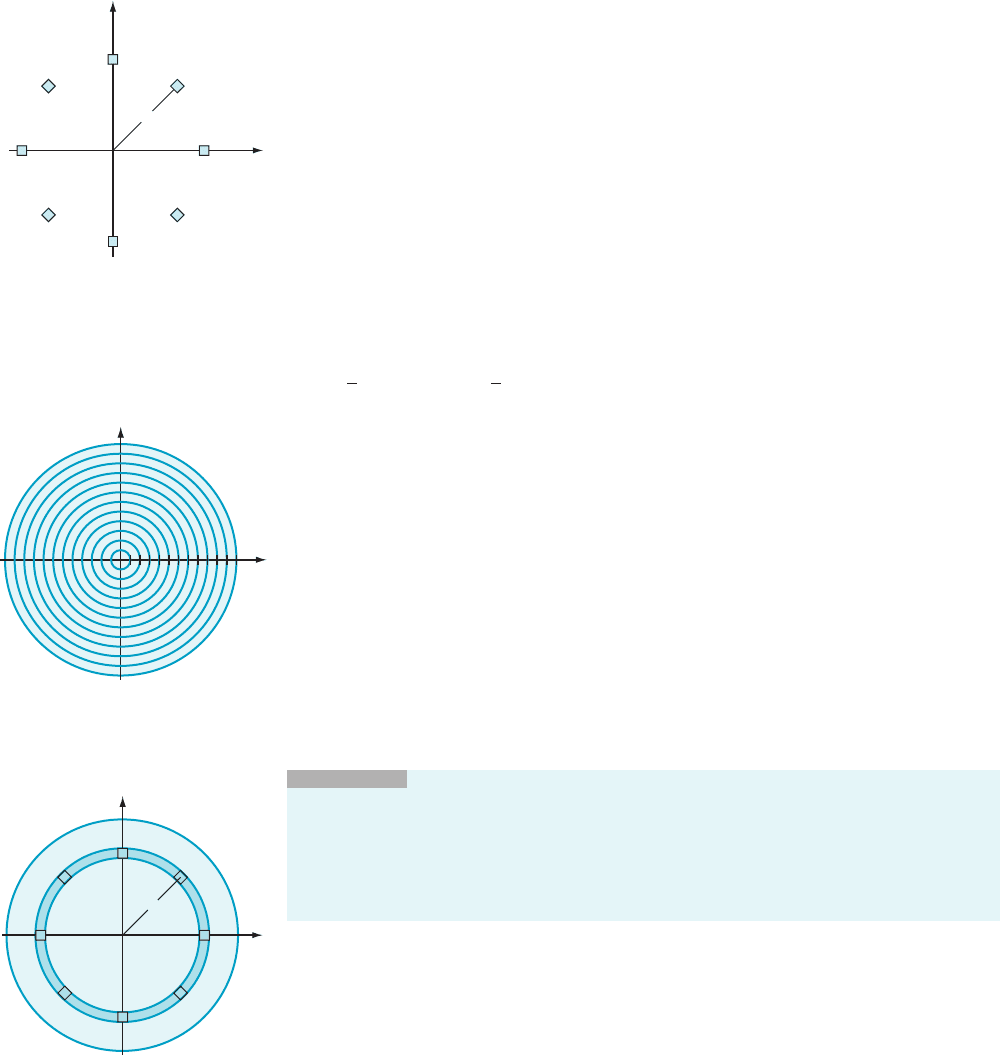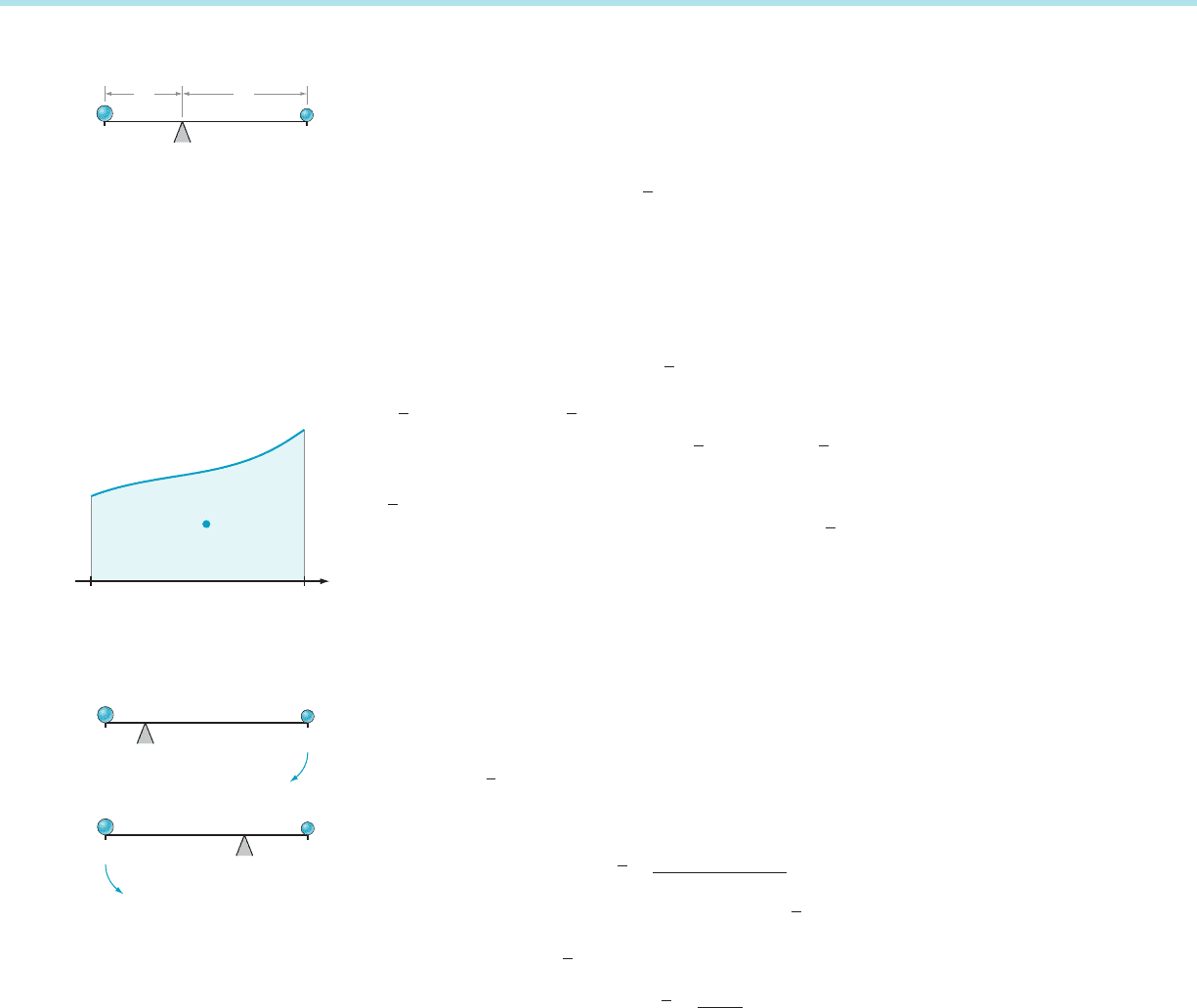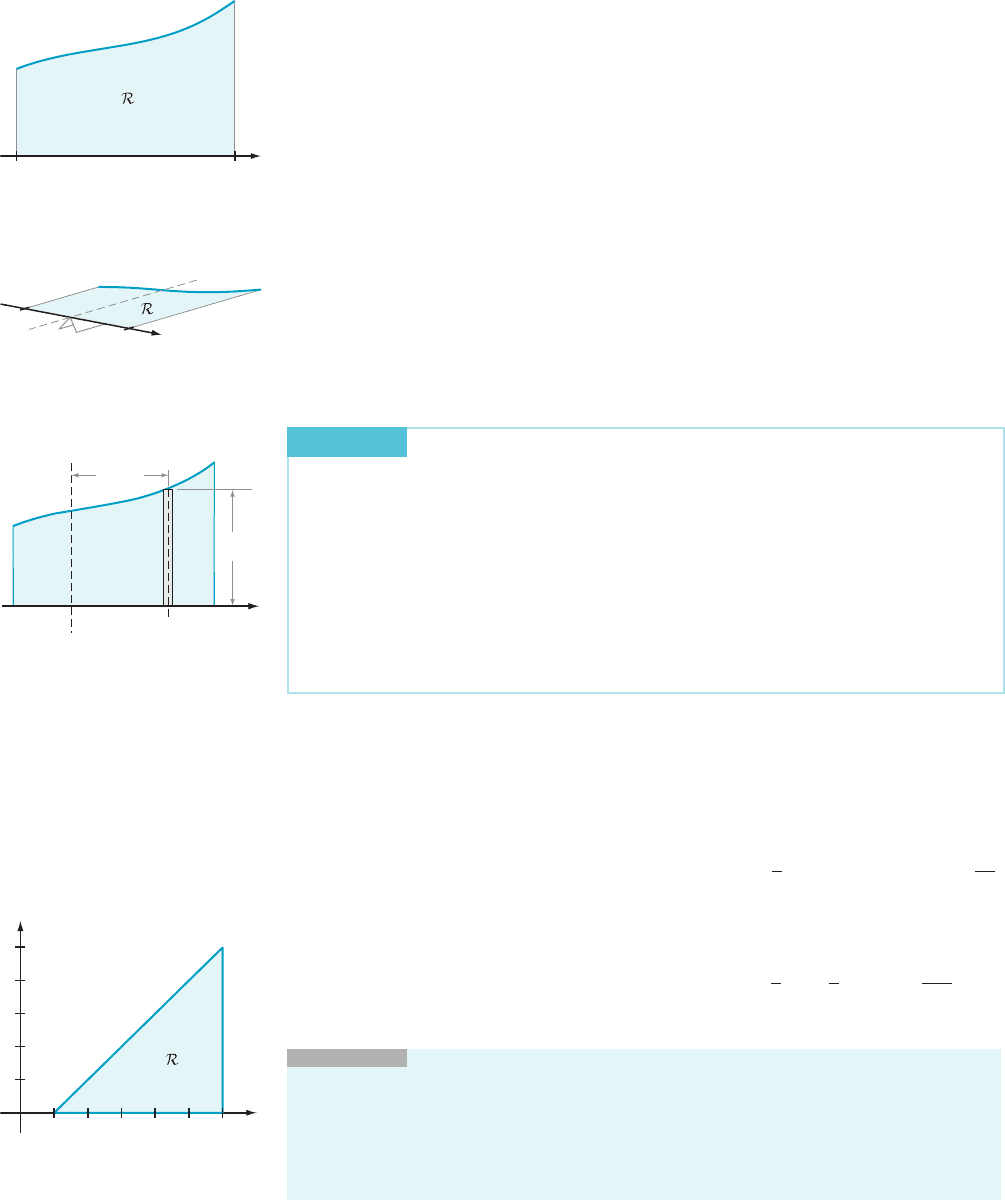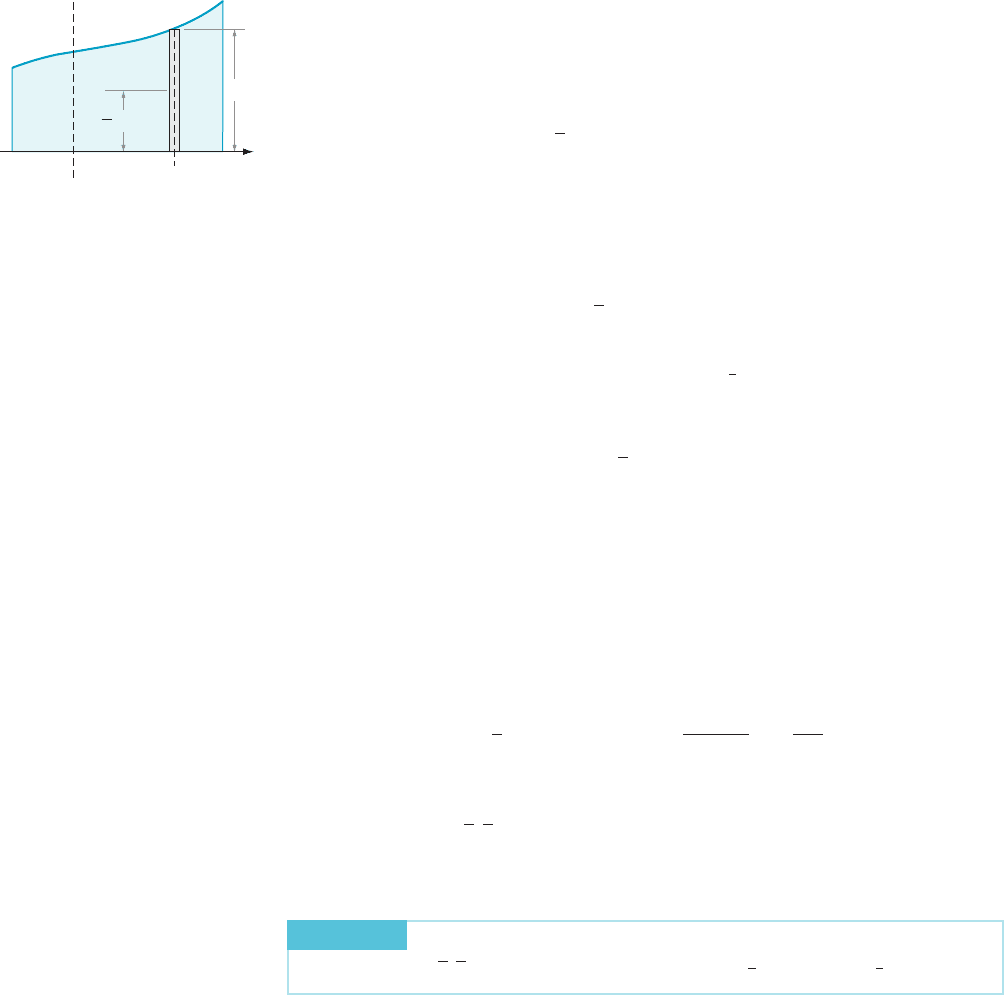Blank B.E., Krantz S.G. Calculus: Single Variable
Подождите немного. Документ загружается.


them, we solve the equation 2x 2 6x
1/2
523. We rewrite this as 2x 1 3 5 6x
1/2
.Ifwe
square each side, then we obtain the quadratic equation (2x 1 3)
2
5 36x or
4x
2
2 24x 1 9 5 0. According to the Quadratic Formula, the roots are
3 2 3
ffiffiffi
3
p
=2 0:40192 and 3 1 3
ffiffiffi
3
p
=2 5:59808. As expected, both roots are in
the interval [0, 9].
¥
Random Variables Many important variables assume their values in a “random” manner. For example,
a company may be able to say quite a bit in general abo ut the longevity of the
computer hard drives it produces. The manufacturer cannot, however, say anything
definite about the lifetime X of the particular hard drive in your computer. We say
that X is a random variable. Similarly, a paleontologist may know what range of
values the heights of velociraptors lie in. What cannot be specified for certain is the
height of the next specimen to be discovered: It is a random variable.
The Theory of Probability is largely concerned with the analysis of random
variables. The field of Statistics uses probability theory to make estimates and
inferences about random variables based on observed values. In this subsection,
you will learn how calculus plays a role in determining the average value of a
random variable.
Suppose that X is a random variable whose values lie in an interval I 5 [a, b]. In
other words, I is the range of X.If[α, β] is a subinterval of I,thenwewrite
P(α # X # β) to denote the probability that the random variable X takes on a value
in the subinterval [α, β]. Just as in everyday informal language, a probability in
mathematics is a number between 0 and 1. For example, we have P(a # X # b) 5 1
because it is certain, according to our assumptions, that X takes a value in this range.
DEFINITION
Suppose that X is a random variable all of whose values lie in an
interval I. If there is a nonnegative function f such that
Pðα # X # βÞ5
Z
β
α
f ðxÞdx ð7:3:3Þ
for every subinterval [α, β]ofI, then we say that f is a probability density
function of X. The abbreviation p.d.f. is commonly used. Sometimes the nota-
tion f
X
is used to emphasize the association between f and X.
⁄ EX
AMPLE 6 In a large class, the grades on a particular exam are all
between 38 and 98. Let X denote the score of a randomly selected student in the
class. Suppose that the probability density function f for X is given by f (x) 5
(136x 2 3724 2 x
2
)/36000, 38 # x # 98. What is the probability that the grade on a
randomly selected exam is between 72 and 82?
Solution Using
formula (7.3.3), we obtain the probability of a random variable X
assuming a value in [α, β] by integrating the probability density function of X over
[α, β]. Thus taking α 5 72 and β 5 82 in formula (7.3.3), we have
Pð72 # X # 80Þ5
Z
82
72
136x 2 3724 2 x
2
36000
dx 5
1
36000
68x
2
2 3724x 2
1
3
x
3
82
72
5
152
675
0:225:
That is, the probability that the indicated grade will be between 72 and 82 is about
0.225.
¥
7.3 The Average Value of a Function 565

As has been discussed, if f is a probability density function of a random variable
X whose values all lie in I 5 [a, b], then
R
b
a
f ðxÞdx 5 1. The co nverse to this
observation is also known: If f is any continuous, nonnegative function such that
R
b
a
f ðxÞdx 5 1, then there is a random variable X that has range I and probability
density function f.
⁄ EX
AMPLE 7 Suppose that g(x) 5 1/x
2
. For what number c is f (x) 5 c g(x)
a probability density function for a random variable whose values all lie in the
interval [1, 3]?
Solution We
calculate
Z
3
1
gðxÞdx 5
Z
3
1
1
x
2
dx 5
2
1
x
3
1
52
1
3
2
1
1
5
2
3
:
Therefore
Z
3
1
f ðxÞdx 5
Z
3
1
cgðxÞdx 5 c
Z
3
1
gðxÞdx 5
2c
3
:
For f to be a probabili ty density function of a random variable with range [1, 3], it is
necessary and sufficient that
Z
3
1
f ðxÞdx 5 1. We therefore set 2c/3 5 1 and find that
c 5 3/2. Thus f (x) 5 3/(2x
2
) is a probability density function on [1, 3]. ¥
In many applications, the range of a random variable is an infinite interval of
the form [a,N)or(2N,N). The next example illustrates this idea with an important
type of random vari able known as a waiting time.
⁄ EX
AMPLE 8 Suppose that f ðxÞ5
1
20000
e
2x=20000
is the probability density
function of the time to failure X, measured in hours, of an electronic component
that has been placed into service. Verify that f is a probability density function on
the interval [0,N), and calculate the probability that the component will fail within
its first 10,000 hours.
Solution Because f is
nonnegative and satisfies
Z
N
0
1
20000
e
2x=20000
dx 5
1
20000
lim
N-N
Z
N
0
e
2x=20000
dx
5
1
20000
lim
N-N
220000 exp
2
1
20000
x
N
0
5 lim
N-N
1 2 exp
2
N
20000
5 1;
we conclude that it is a probability density function. The probability that the
component will fail within its first 10,000 hours is
Pð0 # X # 10000Þ5
Z
10000
0
1
20000
e
2x=20000
dx 52e
2x=20000
x510000
x50
5 1 2 e
21=2
0:3935: ¥
566 Chapter 7 Applications of the Integral

Average Values in
Probability Theory
Suppose that X is a random variable with range I 5 [a, b] and probability density
function f. Our goal is to determine the average value μ of X. Notice that we cannot
simply use our previous formula and integrate X because we do not have a
deterministic formu la for X. We can calculate the average value f
avg
of f, but this
quantity is not the average value μ of X.
To calculate μ, we again rely on a discrete model. If we made a large number N
of observations X
1
,...,X
N
of X, then we would expect
μ
X
1
1 X
2
1 :::1 X
N
N
ð7:3:4Þ
to be a good approximation. Form a partition a 5 x
0
, x
1
, ..., x
M
5 b of the
interval I into M subintervals of equal length Δx. For each j from 1 to M,we
approximate the contribution of the terms in the numerator of formula (7.3.4) that
lie in the j
th
subinterval I
j
5 [x
j21
, x
j
]. First we estimate the number of these
observations. To do so, we note that the probability that an observation of x will fall
in I
j
is
Pðx
j21
# X # x
j
Þ5
Z
x
j
x
j21
f ðxÞdx 5 f ðc
j
ÞΔx
where f (c
j
) is the average value of f in the subinterval I
j
. It follows that about
N ( f (c
j
)Δx) of the observations will lie in I
j
. Each of these observations will be
between x
j21
and x
j
.Becausec
j
is in this small interval, we may use c
j
as a repre-
sentative value of the observations in I
j
. The contribution of the terms in I
j
is therefore
about c
j
(N f (c
j
) Δx). By grouping the summands of X
1
1 X
2
1 ...1 X
N
according
to the subintervals in which they lie, we may rewrite our approximation of μ as
μ
1
N
X
M
j51
c
j
N f ðc
j
ÞΔx
5
X
M
j51
c
j
f ðc
j
ÞΔx:
Because
P
M
j51
c
j
f ðc
j
ÞΔx is a Riemann sum for the integral
R
b
a
xfðxÞdx, we are led
to the following definit ion.
DEFINITION
If f is the probability density function of a random variable X that
takes values in an interval I 5 [a, b], then the average (or mean) μ of X is defined
to be
μ 5
Z
b
a
xfðxÞdx: ð7:3:5Þ
This value is also said to be the expectation of X. Other notations for the
expectation of X are
X and E(X).
⁄ EX
AMPLE 9 Let X denote the fraction of total impurities that are filtered
out in a particular purification process. Suppos e that X has probability density
function f (x) 5 20x
3
(1 2 x) for 0 # x # 1. What is the average of X?
Solution Acco
rding to our definition, the average is
X 5
Z
1
0
x 20x
3
ð1 2 xÞdx 5
Z
1
0
ð20x
4
2 20x
5
Þdx 5 20
x
5
5
2
x
6
6
x51
x50
5
2
3
: ¥
7.3 The Average Value of a Function 567

Population Density
Functions
The idea of a density function arises in many topics outside of probability theory. In
the next section, we will encounter mass densities, which are important in physics
and engineering. We conclude the present section with a discussion of population
densities, which are used for societal planning.
In a simple model for the growth of a city, the municipality’s land mass expands
radially in all directions from the central point of its initial foundation. We
represent the city’s center by the origin in the plane and supp ose that there are no
geographic or economic factors that favor one radial direction over another for
settlement. As a result of this assumption, the num ber of people living in a small
square R of area A is about f (r) A, where f (r) is a proportionality constant
depending on the distance r of the center of R from the origin but not on the
particular location of the center on the circle x
2
1 y
2
5 r
2
(see Figure 4). Let us use
this population density f to calculate the number P(R) of inhabitants living up to a
distance R from the city center.
The partition x
0
5 0, x
1
5 R/N, x
2
5 2R/N,...,x
N21
5 (N 2 1) R/N, x
N
5 R divides
the interval [0, R] of the x-axis into N subintervals of equal length Δx 5 R/N. We can
use this partition of [0,R] to divide the disk of radius R centered at the origin into N
concentric rings, as shown in Figure 5. Let s
j
be the midpoint of the j
th
subinterval
[x
j21
, x
j
]of[0,R]. Then, for 2 # j # N, the area A
j
of the j
th
ring is eq ual to
π
s
j
1
1
2
Δx
2
2 π
s
j
2
1
2
Δx
2
; or 2π s
j
Δx. We can also use this expression as an
approximation to the area A
1
of the first “ring,” which is actually a disk. In Figure 6,
several squares are drawn inside the j
th
ring. Each has side length Δx and a center that
is a distance s
j
from the origin. If we continue to fill in the ring with such squares until
the ring is approximately covered, then each square in the covering has area A 5
(Δx)
2
and approximately f (s
j
) A inhabitants. If we sum the contributions of these
squares to the total population P
j
of the j
th
ring, then, afte r factoring the common
coefficient f (s
j
), we obtain P
j
f ðs
j
Þ3 A
j
,orP
j
2π s
j
f ðs
j
ÞΔx. Because the total
population P(R) in the disc of radius R centered at the origin is equal to P
1
1 P
2
1
...1 P
N
, we see that PðRÞ
P
N
j51
2π s
j
f ðs
j
ÞΔx. Observe that this expression is a
Riemann sum for the integral
R
R
0
2π xfðxÞdx. Thus on letting N tend to infinity, we
obtain
PðRÞ5 2π
Z
R
0
xfðxÞdx: ð7:3:6Þ
INSIGHT
Despite the apparent similarity between the integrals of formulas (7.3.5)
and (7.3.6), there are significant differences that should be noted. The probability density
function of formula (7.3.5) is integrated over the range of the random variable X. The
population density function of formula (7.3.6) is integrated over a subinterval of the
domain of the population function P. Equation (7.3.5) is a formula for the average value
of X. Equation (7.3.6) can be used to calculate all values of P.
⁄ EXAMPLE 10 In 1950, the population density of Tulsa was given by
f (x) 5 28000e
24x/5
, where x represents the distance in miles from the central
business district. About how many people lived within 20 miles of the city center?
Solution Accord
ing to formula (7.3.6), Pð20Þ5 2π
R
20
0
28000 xe
24x=5
dx. Using
formula (6.1.9) with n 5 1 and a 524/5, we have
y
The population in each shaded square
of area A is about f
(
r
)
· A
r
x
m Figure 4
y
R
x
m Figure 5
y
s
j
x
j
x
j1
x
m Figure 6
568 Chapter
7 Applications of the Integral

Pð20Þ5 56000 π
2
5
4
xe
24x=5
20
0
1
5
4
Z
20
0
e
24x=5
dx
5 56000 π
225 e
216
1
5
4
2
5
4
e
24x=5
20
0
5 56000 π
225 e
216
1
25
16
2
25
16
e
216
5 56000
25
16
π ð1 2 17e
216
Þ
274 ; 889: ¥
QUICK QUIZ
1. What is the average of sin(x) over the interval [0, π]?
2. For what c in I 5 [0, 3] is f (c) the average value of f (x) 5 x
2
on I?
3. Suppose that the probability density of a nonnegative random variable X is
f (x) 5 exp(2x), 0 # x ,N. What is the probability that X # 1?
4. What is the mean of a random variable that has probability density function
f (x) 5 x/2 for 0 # x # 2?
Answers
1. 2/π 2.
ffiffi
ffi
3
p
3. 1 2 1/e 4. 4/3
EXERCISES
Problems for Practice
c In each of Exercises 1212, calculate the average value of
the given function on the given interval. b
1. f (x) 5 cos(x) I 5 [0, π/2]
2. f (x) 5 x
2
I 5 [3, 7]
3. f (x) 5 1/xI5 [1, 4]
4. f (x) 5 3x
2
2 6x 1 1 I 5 [3, 7]
5. f (x) 5 sin(x) I 5 [π/3, π]
6. f (x) 5 1 1 cos(x) I 5 [0, 2π]
7. f (x) 5 (x 2 1)
1/2
I 5 [2, 5]
8. f (x) 5 x
1/2
2 x
1/3
I 5 [0, 64]
9. f (x) 5 60/x
2
I 5 [1, 3]
10. f (x) 5 e
x
I 5 [21, 1]
11. f (x) 5 ln(x) I 5 [1, e]
12. f (x) 5 x
ffiffiffiffiffiffiffiffiffiffiffiffiffiffiffiffiffiffi
169 2 x
2
p
I 5 [5, 12]
c In each of Exercises 13216, a function f and
an interval
I 5 [a, b] are given. Find a number c in (a, b) for which f (c)is
the average value of f on I. b
13. f (x) 5 1/xI5 [1,
3]
14. f (x) 5 e
x
I 5 [ln(2), ln(4)]
15. f (x) 5 x
2
2 10x/3 I 5 [1, 3]
16. f (x) 5 ln(x) I 5 [1, e]
c In each of Exercises 17222, the probability density function
f of
a random variable X with range I 5 [a, b] is given. Calculate
P(α # X # β) for the given subinterval J 5 [α, β]ofI. b
17. f (x) 5 3x
2
/8 I 5 [0, 2] J 5 [1, 2]
18. f (x) 5 12x
2
(1 2 x) I 5 [0, 1] J 5 [0, 1/2]
19. f (x) 5 sin(x)/2 I 5 [0, π] J 5 [π/4, π/2]
20. f (x) 5 3(1 1 x)/(8
ffiffiffi
x
p
) I 5 [0, 1] J 5 [1/4, 1/2]
21. f (x) 5 e
12x
/(e 2 1) I 5 [0, 1] J 5 [0, 1/2]
22. f (x) 5 ln(x) I 5 [1, e] J 5 [3/2, 2]
c In each of Exercises 23228, a function g and
an interval I
are specified. The function g is nonnegative on I. Find a
number c such that f (x) 5 cg(x) is a probability density
function on I. b
23. g(x) 5 sec
2
(x) I 5 [0, π/3]
24. g(x) 5 1/x
2
I 5 [1, 2]
25. g(x) 5 9 2 x
2
I 5 [21, 3]
26. g(x) 5 e
2x
I 5 [0, 1]
27. g(x) 5 e
22x
I 5 [0,N]
28. g(x) 5 1/(1 1 x
2
) I 5 (2N,N)
c In each of Exercises 29236, calculate the mean of the
random
variable whose probability density function is
given. b
7.3 The Average Value of a Function 569

29. f (x) 5 3x
2
I 5 [0, 1]
30. f (x) 5 2(1 2 x) I 5 [0, 1]
31. f (x) 5 1/(3
ffiffiffi
x
p
) I 5 [1/4, 4]
32. f (x) 5 6x(1 2 x) I 5 [0, 1]
33. f (x) 5 x
2
/3 I 5 [21, 2]
34. f (x) 5 3/(π(1 1 x
2
) I 5 [0,
ffiffiffi
3
p
35. f ðxÞ5
2lnðxÞ
x
I 5 ½1; e
36. f ðxÞ5
2
π
ffiffiffiffiffiffiffiffiffiffiffiffiffi
1 2 x
2
p
I 5 ½0; 1
37. In 1980, the population density for the central core of
Houston, a disk with a 6-mile radius, was f (x) 5 5860
exp(20.148x). What was the population of that part of
Houston?
38. In 1960, the population density for the central core of
Denver, a 72 mi
2
disk, was f (x) 5 14000 exp(2x/4). What
was the population of that part of Denver?
Further Theory and Practice
39. In 1950, the population density in the central core of
Akron, a disk with a 4-mile radius, was f ( x) 5 13000
exp(20.38x). In 1970, the population density was f (x) 5
10000 exp(20.29x). Did the population in that part of
Akron increase or decrease? By about how many people?
40. If a city’s population density is given by f (x) 5
A/(B 1 Cx) for positive constants A, B, and C, then how
many people live farther than a distance a from the center
but closer than a distance b from the center?
41. A patient with a fever has temperature at time t (mea-
sured in hours) given by
TðtÞ5 99: 6 2 t 1 0:8t
2
degrees;
where temperature is measured in degrees Fahrenheit.
Find the patient’s average temperature as t ranges from 0
to 3.
42. The temperature distribution on a uniform rod of length 4
meters is T(s) 5 18 1 6s
2
2 2s 1
ffiffi
s
p
,0# s # 4. What is the
average temperature of the rod?
c In each of Exercises 43252 calculate the average of the
given
expression over the given interval. b
43. x exp(x
2
)0# x # 2
44. x sin(x)0# x # π
45. 3π cos(x)
ffiffiffiffiffiffiffiffiffiffiffiffiffiffiffiffiffiffiffiffi
1 1 sinðxÞ
p
0 # x # π/2
46. sin
3
(x)0# x # π
47. cos
2
(x) sin
3
(x)0# x # π
48. sin
2
(2x)0# x # π/2
49. 4x ln(x)1# x # e
50. ln(x)/x 1 # x # e
51.
5x 1 2
x
2
1 x
1 # x # 3
52. 24x arcsin(x)0# x # 1/2
53. For what value of c is 21/2 the average value of (x 2 c)
sin(x) over the interval [0, π/3]?
54. Is the average value of cos(x) for 0 # x # π/4 equal to the
reciprocal of the average value of 1/cos(x) over the same
x-interval?
55. The outdoor temperature in a certain town is given by
TðtÞ5 40 2 ðt 2 45Þ
2
=200
for t ranging from 0 to 72 hours. Use the definition of
degree days given in Example 3 to calculate the degree
days for each of the three successive 24-hour periods. If
fuel costs a certain homeowner $0.30 per degree day, what
does it cost her to heat her house during these three days?
56. The temperature of an aluminum rod at point x is given by
TðxÞ5
t
3
2 t
2
1 32; 0 # t # 2
36 2 2t 1 t
2
; 2 , t # 8:
Find the average temperature of the rod.
57. For what a, 0 # a # π, does the function f (x) 5 sin(x) 2
cos(x) have the greatest average over the interval
[a, a 1 π] of length π?
58. Given c . 0, for what value b,0, b , c, is exp(b) equal to
the average of exp(x) for 0 # x # c.
c In each of Exercises 59264, a nonnegative continuous
function g and
an interval I are specified. The function g is
nonnegative on I. Find a positive real number c for which
f (x) 5 cg(x) is a probability density function. b
59. g(x) 5 x ln(x)
[1, e]
60. x
3
(1 2 x)
2
[0, 1]
61. x
2
(1 2 x
3
)
21/2
[0, 1]
62. (9 1 x
2
)
21/2
[0, 4]
63. arcsin(x) [0, 1]
64. x(1 2 x)
21/2
[0, 1]
c In each of Exercises 65274 calculate the expectation of a
random
variable whose probability density function is
given. b
65.
1
2
sinðxÞ 0 # x # π
66.
1
2π
1 1 cosðxÞ
0 # x # 2π
67.
4x
ðx
2
1 1Þ
2
0 # x # 1
68. e
12x
=ðe 2 1Þ 0 # x # 1
69.
3
16
ffiffiffiffiffiffiffiffiffiffiffi
4 2 x
p
0 # x # 4
70.
4arctanðxÞ
π 2 2lnð2Þ
0 # x # 1
71. 2e
22x
0 # x ,N
72.
2
ffiffiffi
π
p
expð2x
2
Þ 0 # x , N
570 Chapter 7 Applications of the Integral

73.
4
πð1 1 x
2
Þ
2
0 # x , N
74.
2x
ð1 1 x
2
Þ
2
0 # x , N
c If P(X # m) 5 P(X $ m) 5 1/2,
then we say that m is the
median of a random variable X . In each of Exercises 75278,
calculate
the median of a random variable whose probability
density function f is given. b
75. f (x) 5 cos(x)0# x # π/2
76. f (x) 5 3x
2
/26 1 # x # 3
77. f (x) 5 e
12x
/(e 2 1) 0 # x # 1
78. f (x) 5 4x(1 2 x
2
)0# x # 1
79. Let p be a positive constant. Let X be a random variable
with range [0, 1] and probability density function f (x) 5
( p 1 1)x
p
,0# x # 1. Show that X 6¼ f
avg
. (In general, the
average of a random variable is not equal to the average
of its probability density function.)
80. Let p be a positive constant. Suppose that X is a random
variable with probability density function f (x) 5 ( p 1 1)
x
p
for 0 # x # 1.
a. Show that g(u) 5 1 1 u 2 2
u
satisfies 0 , g
0
(u)
for 0 , u , log
2
(1/ln(2)) 0.529, and g
0
(u) , 0 for
log
2
(1/ln(2)) , u.
b. Use the values g(0) 5 g(1) 5 0 together with the
inequalities of part a to deduce that 0 , g(u) for
0 , u , 1.
c. By setting u 5 1/(p 1 1) in the inequality 0 , g(u),
deduce that
2
1=ðp 1 1Þ
,
p 1 2
p 1 1
:
d. Show that the mean of X is not equal to the median
of X. (In general, the mean of a random variable is not
equal to its median.)
81. Suppose that f is a continuous positive function on the
unbounded interval [a,N). Is it appropriate to make the
definition
f
avg
5 lim
N-N
1
N 2 a
Z
N
a
f ðxÞdx?
Discuss why or why not.
82. Let λ be a positive constant. Show that f ðxÞ5
λexpð2λxÞ; 0 # x , N is a probability density function.
Show that the mean of a random variable with probability
density function f is 1/λ.
c If μ is
any real number, and σ is any positive real number,
then
f
μ;σ
ðxÞ5
1
ffiffiffiffiffiffi
2π
p
σ
exp
2
1
2
x 2 μ
σ
2
; 2N , x , N
is a probability density function. Exercises 83 and 84 are
concerned
with a random variable X that has probability
density function f
μ,σ
. Such an X is called a normal or Gaussian
random variable. If μ 5 0 and σ 5 1, we use the term standard
normal. The parameter σ is called the standard deviation of
X. b
83. Show
that μ is the mean of a random variable that has
probability density function f
μ, σ
.
84. Suppose that X is a random variable that has probability
density function f
μ,σ
. Prove that
Pðμ 2 k σ # X # μ 1 k σÞ5
1
ffiffiffiffiffiffi
2π
p
Z
k
2k
exp
2
1
2
x
2
dx:
Calculator/Computer Exercises
c In each of Exercises 85288,afunctionf is given. Let A
f
(c)
denote the average value of f over the interval [c 2 1/4, c 1 1/4].
Plot y 5 f (x)andy 5 A
f
(x)for 21 # x # 1. The resulting plot
will illustrate the gain in smoothness that results from
averaging. b
85. f (x) 5 |x|
86. f (x) 5
ffiffiffiffiffi
jxj
p
87. f ðxÞ5
0i
fx , 0
1if0# x
88. f ðxÞ5
x
2
if x , 0
x
2
1 x if 0 # x
c In each of Exercises 89292, a function f and
an interval I
are given. Calculate the average f
avg
of f over I, and find a
value c in I such that f (c) 5 f
avg
. State your answers to three
decimal places. b
89. f ðxÞ5
ffiffi
ffi
x
p
expð2xÞ I 5 ½0; 4
90. f ðxÞ5 sinðπðx
2
2 x
3
ÞÞ I 5 ½0; 1
91. f ðxÞ5 x=ð16 1 x
3
Þ I 5 ½2; 4
92. f ðxÞ5
lnðxÞ
1 1 x
I 5 ½1; e
93. What is the probability that the value of a normal random
variable is within one standard deviation of the mean?
Refer to Exercise 84.
94. What is the probability that the value of a normal random
variable is within two standard deviations of the mean?
Refer to Exercise 84.
7.3 The Average Value of a Function 571

7.4 Center of Mass
When two children of different masses m
1
and m
2
play on a seesaw, they find that
they can balance the seesaw if they position themselves appropriately. Let us set up
a simple model of the seesaw. Suppose that two point masses m
1
and m
2
are
situated at endpoints of an interval [x
1
, x
2
] on the x-axis, as in Figure 1. If a fulcrum
could be positioned unde rneath the axis, and if the interval could pivot about the
fulcrum, then at what coordinate
x should we place the fulcrum so as to achieve a
balance? According to the lever law of physics, the masses are in balance if and
only if the distances d
1
and d
2
to the fulcrum satisfy the equation m
1
d
1
5 m
2
d
2
.In
this section, we will use this simple principle, together with calculus, to determine
the balancing point of a planar region such as the one shown in Figure 2.
Moments (Two Point
Systems)
Before turning our attention to planar figures, it is useful to study the seesaw of
Figure 1 in greater detail. The point
x is said to be the center of mass of the system.
We may rewrite the equation m
1
d
1
5 m
2
d
2
in terms of the center of mass as follows:
m
1
(x 2 x
1
) 5 m
2
(x
2
2 x)or
0 5 m
1
ðx
1
2 xÞ1 m
2
ðx
2
2 xÞð7:4:1Þ
The right side of equation (7.4.1) is said to be the moment about the vertical axis
x 5
x. The lever law as expressed by equation (7.4.1) tells us that our system will
balance if and only if the moment about the axis x 5
x is zero. In general, if we
position the fulcrum at any point x 5 c, then we define the moment M
x5c
about the
axis x 5 c to be the expression
M
x5c
5 m
1
ðx
1
2 cÞ1 m
2
ðx
2
2 cÞ: ð 7 :4:2Þ
The moment about the y-axis,
M
x50
5 m
1
x
1
1 m
2
x
2
; ð7:4:3Þ
is an important special case. Moments may be positive, negative, or 0. In the first
two cases, the axis will swing about the fulcrum as shown in Figure 3.
Equations (7.4.1) and (7.4.2) provide us with a method of determining the
center of mass
x of our two point system; we set M
x5c
5 0 in equation (7.4.2) and
solve for c. Thus 0 5 m
1
ðx
1
2 cÞ1 m
2
ðx
2
2 cÞ; or m
1
c 1 m
2
c 5 m
1
x
1
1
m
2
x
2
; or c 5 ðm
1
x
1
1 m
2
x
2
Þ=ðm
1
1 m
2
Þ. Thus
x 5
m
1
x
1
1 m
2
x
2
m
1
1 m
2
:
Notice that the numerator of this expression for
x is the right side of equation
(7.4.3). If we let M 5 m
1
1 m
2
denote the total mass of the system, then we can
rewrite our formula for
x in the form
x 5
M
x50
M
:
Moments Now let’s consider the region R shown in Figure 4. We suppose that the region has
uniform mass density δ. By this we mean that the mass of any subset of R is δ times
the area of the subset. Imagine the xy-plane to be horizontal and position a fulcrum
underneath the axis x 5 c (Figure 5). What must c be so that region R does not
swing to one side or the other? To answer this question, we form a partition
m
1
x
1
m
2
d
1
Fulcrum at
x x
–
d
2
x
2
m Figure 1
ab
P
y f(x)
x
m Figure 2 The shaded region
balances at point P.
M
xa
0
M
xa
0
x
1
Fulcrum at
x a
x
2
x
1
Fulcrum at
x a
x
2
m
1
m
2
m
1
m
2
m Figure 3
572 Chapter
7 Applications of the Integral

a 5 x
0
, x
1
, ..., x
N
5 b of the interval [a, b]. Let Δx denote the common length of
the subintervals, and let s
j
be the midpoint of the j
th
subinterval I
j
. We divide region R
into the N pieces that lie over the subintervals I
1
, I
2
,...,I
N
. The piece that lies over I
j
is approx imately a rectangle with base Δx and height f (s
j
)—see Figure 6. The mass of
this piece is theref ore approximately equal to δf (s
j
)Δx. Notice that, if Δx is small,
then the points in this j
th
piece of R are all approximately a (signed) distance (s
j
2 c)
from the axis x 5 c. The contribution that this piece makes to the tendency of R to
pivot about x 5 c is therefore ab out (s
j
2c) δf (s
j
)Δx. The total tendency (or moment)
M
x5c
to pivot about the axis x 5 c is approximately
X
N
j51
ðs
j
2 cÞδf ðs
j
ÞΔx: ð7:4:4Þ
As N increases, Δx decreases, and exp ression (7.4.4) becomes a better approximation
to the tendency of R to rotate about the line x 5 c. Because expression (7.4.4) is a
Riemann sum for the integral
R
b
a
ðx 2 cÞδf ðxÞdx, we are led to the following
definition.
DEFINITION
Let c be any real number. Suppose that f is contin uous and
nonnegative on the interval [a, b]. Let R denote the planar region bounded
above by the graph of y 5 f (x), below by the x-axis, and on the sides by the line
segments x 5 a and x 5 b.IfR has a uniform mass density δ, then the moment
M
x5c
of R about the axis x 5 c is defined by
M
x5c
5
Z
b
a
ðx 2 cÞδ f ðxÞdx 5 δ
Z
b
a
ðx 2 cÞf ðxÞdx:
Notice that the moment M
x5c
is defined even if the number c is not between a
and b.
⁄ EX
AMPLE 1 Let R be the region bounded by y 5 x 2 1, y 5 0, and x 5 6
(as shown in Figure 7). Suppose that R has uniform mass density δ 5 2. Calculate
the moments about the axes x 5 5 and x 5 0.
Solution The
required moments are
M
x55
5 2
Z
6
1
ðx 2 5Þðx 2 1Þdx 5 2
Z
6
1
ðx
2
2 6x 1 5Þdx 5 2
1
3
x
3
2 3x
2
1 5x
6
1
52
50
3
and
M
x50
5 2
Z
6
1
ðx 2 0Þðx 2 1Þdx 5 2
Z
6
1
ðx
2
2 xÞdx 5 2
1
3
x
3
2
1
2
x
2
6
1
5
325
3
: ¥
INSIGHT
In Example 1, the signs of M
x55
and M
x50
could have been determined
simply by inspecting Figure 7. Imagine a horizontal plate in the shape of R . Our
experience tells us that, if the plate were allowed to pivot about the axis x 5 5, then the
left side would fall. From this, we conclude that M
x55
, 0. (It may be useful to refer back
to Figure 3, which illustrates the analogous behavior of a seesaw.) Similar reasoning leads
to the conclusion that M
x50
must be positive.
ab
y f(x)
x
m Figure 4
x
b
a
y f(x)
x c
m Figure 5
a
b
x
x c
y f(x)
f(s
j
)
c
s
j
x
j
x
j1
s
j
c
x
m Figure 6
5
4
3
2
1
y
y x 1
x
x 6
123456
m Figure 7
7.4 Center of Mass 573

Consider again the region R that is shown in Figure 4. We would like to define
the moment M
y5d
of R about a horizontal axis y 5 d. Unfortunate ly, we cannot do
so in a way that is analogous to the definition of moments about vertical axes. The
reason can be seen in Figure 6. The key idea behind the definition of the moment
M
x5c
is that, if the rectangle is thin, then the point masses within the rectangle are
nearly equidistant from the vertical axis x 5 c. Clearly that cannot be true for any
horizontal axis.
A thorough solution to the problem of defining M
y5d
requires multivariable
calculus. For now, let us consider only the mom ent M
y50
, the moment about the x-
axis. Glance at Figure 8. The average distance to the x -axis of the points in the
rectangle is f (s
j
)/2. It therefore seems plausible to use
1
2
f ðs
j
Þ
|fflffl{zfflffl}
Average distance
δf ðs
j
ÞΔx
|fflfflfflfflffl{zfflfflfflfflffl}
Approximate mass
as an approximation of the moment of the rectangle about the x-axis. Then the
resulting approximation to the total moment of R about the x-axis is
X
N
j51
1
2
f ðs
j
Þδf ðs
j
ÞΔx:
Because this is a Riemann sum of the integral
R
b
a
1
2
δf ð x Þ
2
dx, we are led to define
M
y50
by the formula
M
y 5 0
5
1
2
δ
Z
b
a
f ðxÞ
2
dx: ð7:4:5Þ
After we have studied some multivariable calculus, we will have the tools to rig-
orously justify this formula.
⁄ EX
AMPLE 2 Let R be the region bounded by y 5 x 2 1, y 5 0, and x 5 6
(as in Example 1). Suppose that R has uniform mass density δ 5 2. Calculate the
moment M
y50
.
Solution Accord
ing to formula (7.4.5), the required moment is
M
y50
5
1
2
ð2Þ
Z
6
1
ðx 2 1Þ
2
dx 5
ðx 2 1Þ
3
3
6
1
5
125
3
: ¥
Center of Mass The center of mass (x, y) of a region R is the point at which the region balances (as
in Figure 2). To find the center of mass, we must translate this physical property
into mathematical equations.
DEFINITION
Let R be a region as shown in Figure 4. Then the center of mass of
R is the point (
x, y) whose coordinates satisfy M
x5x
5 0 and M
y5y
5 0.
a
b
x c
y f(x)
f(s
j
)
f(s
j
)
c
1
2
s
j
x
j
x
j1
x
m Figure 8
574 Chapter
7 Applications of the Integral
